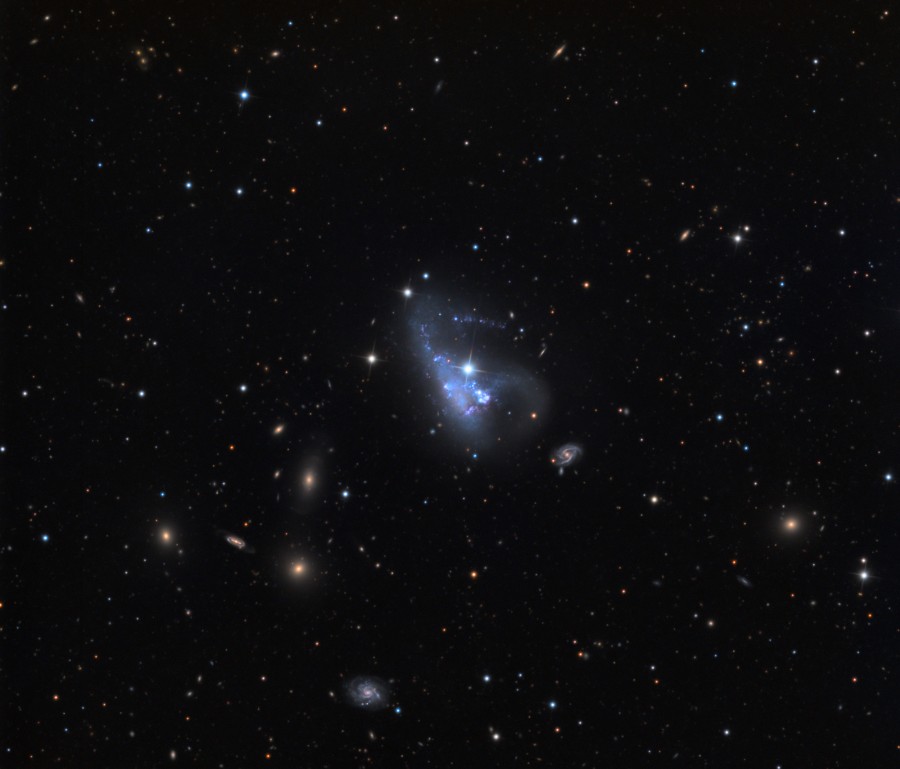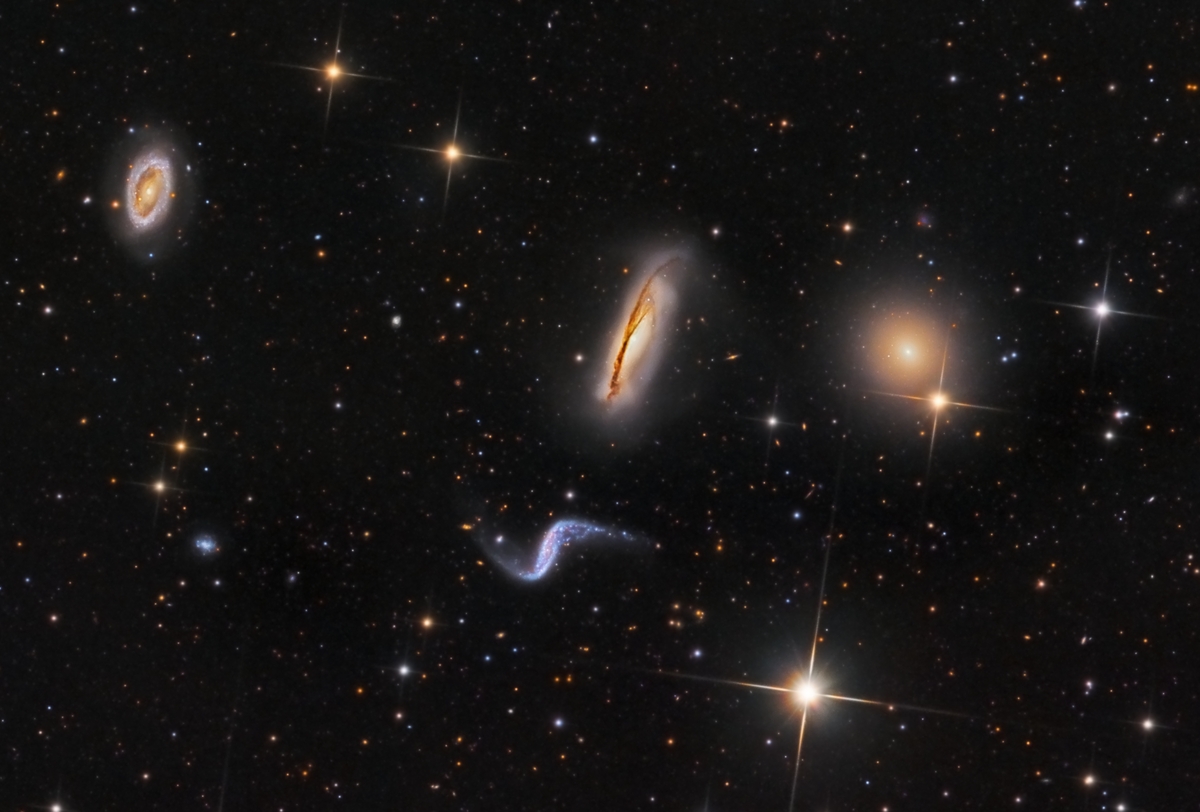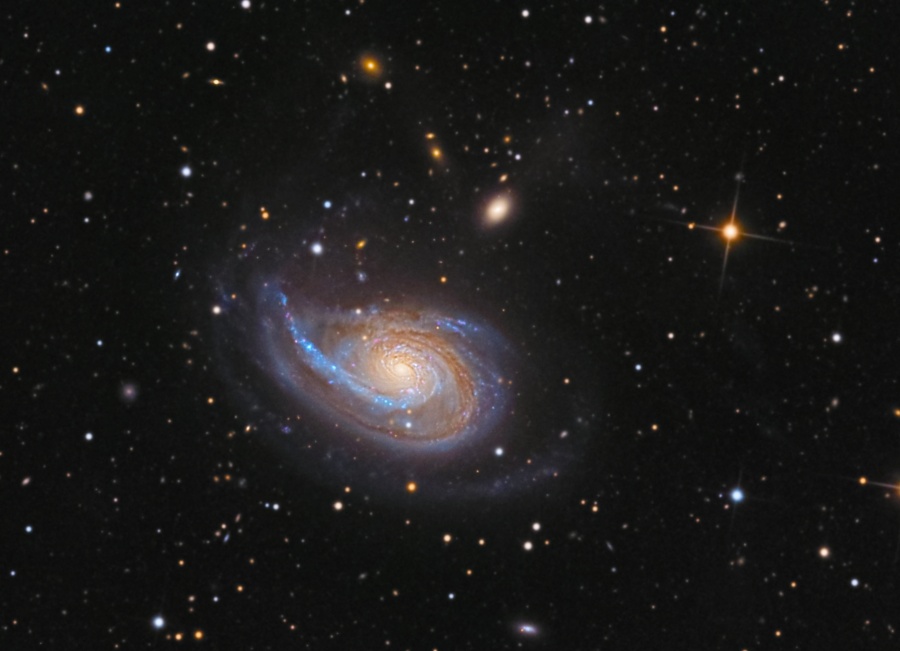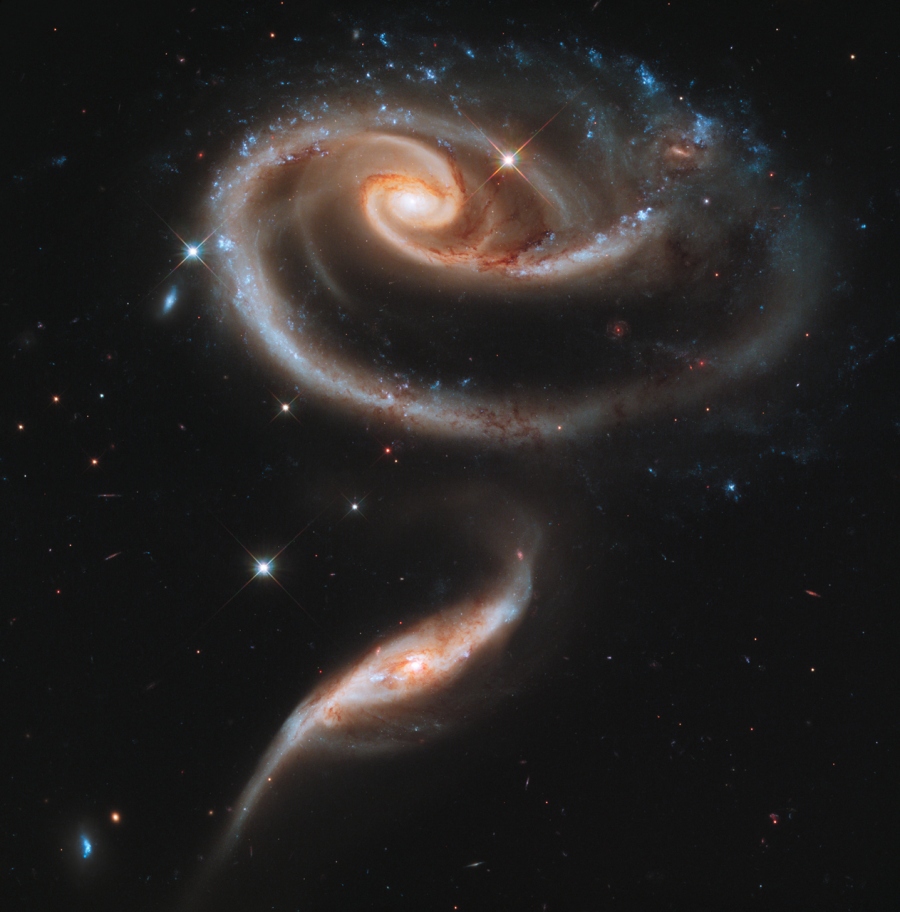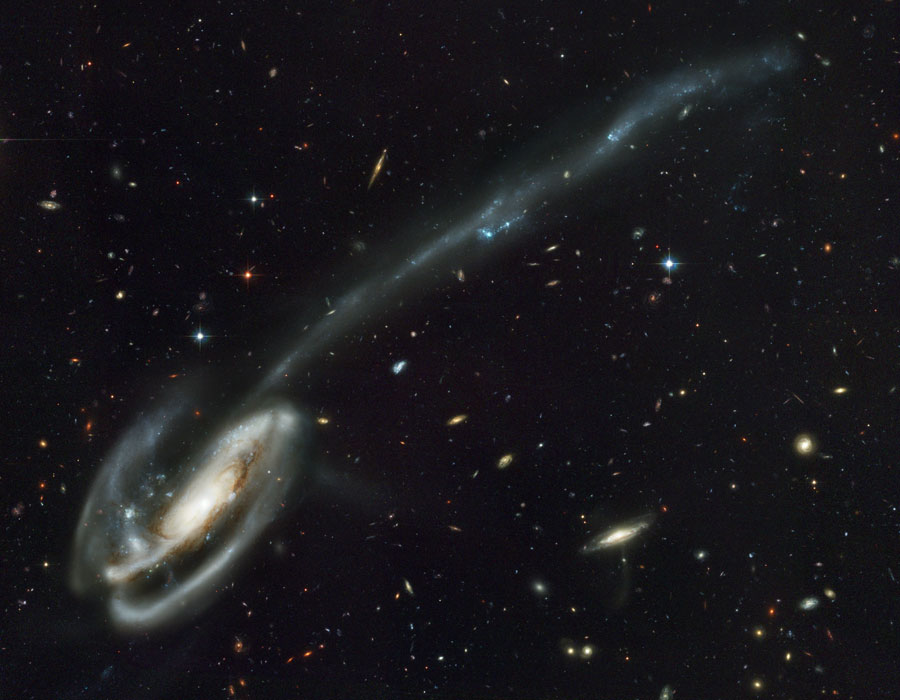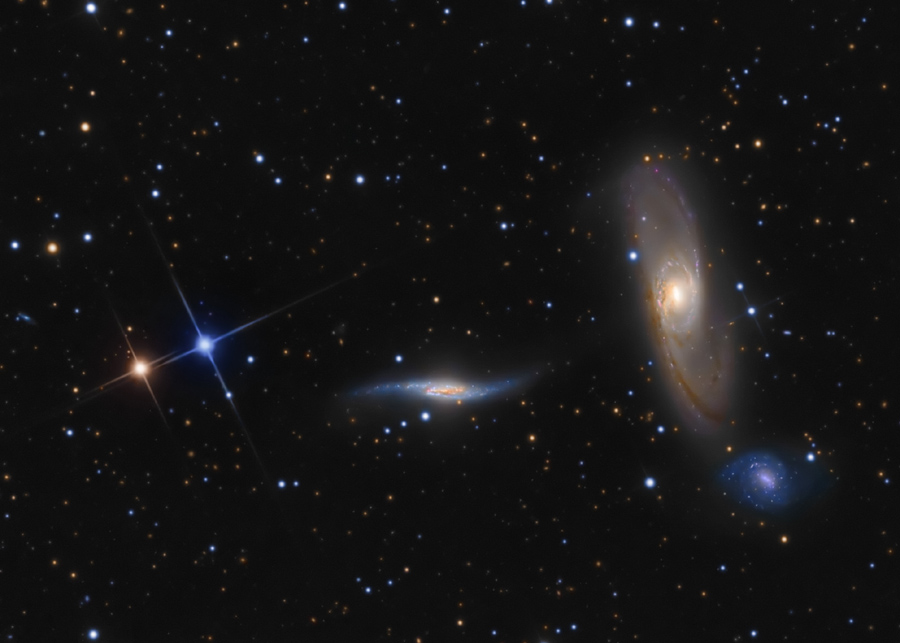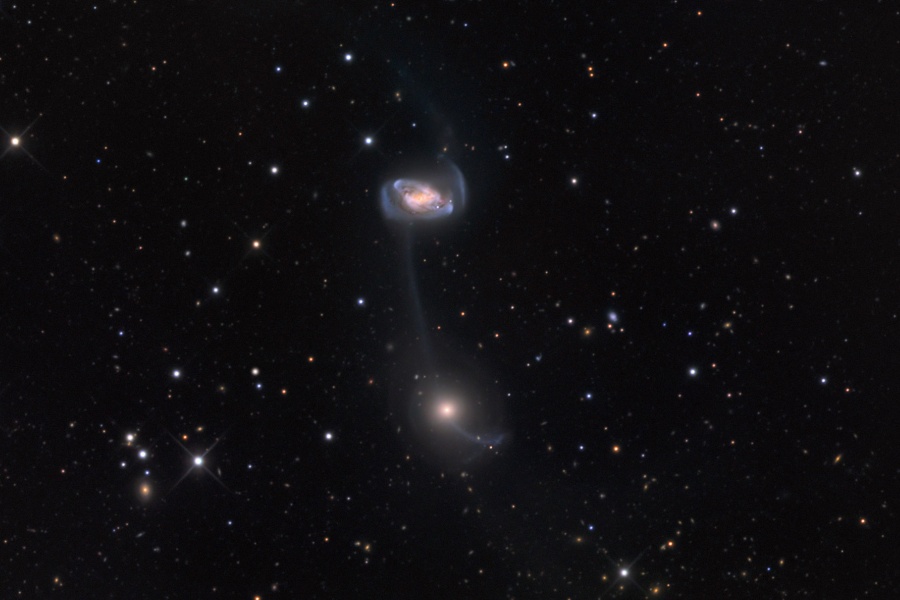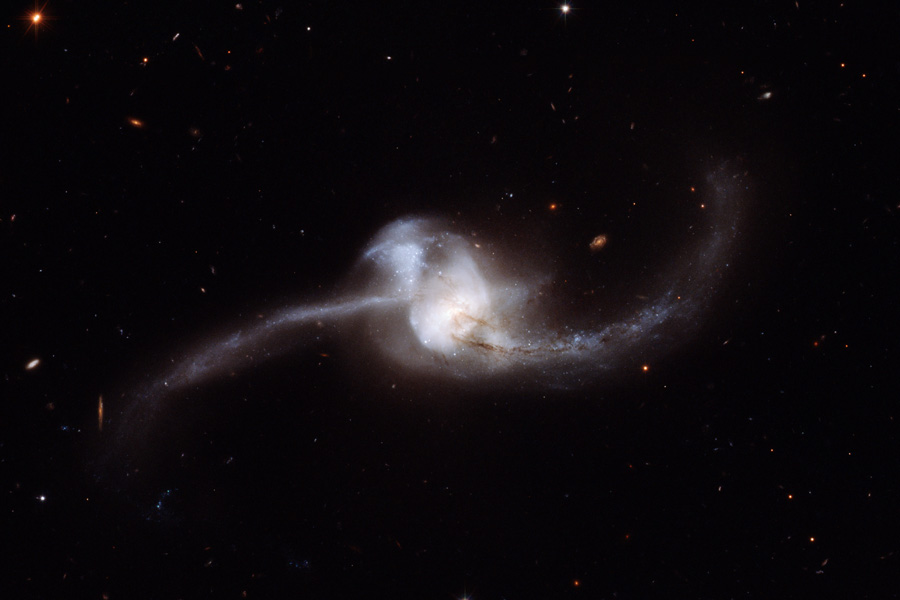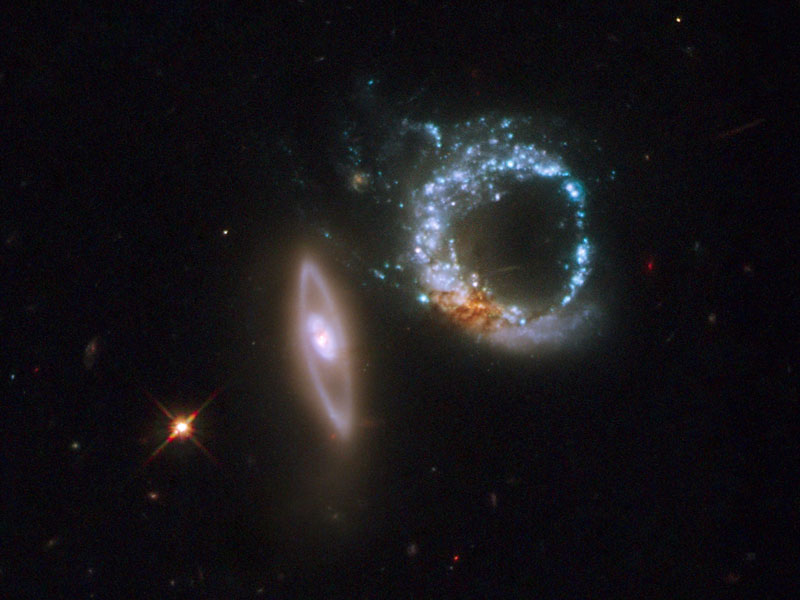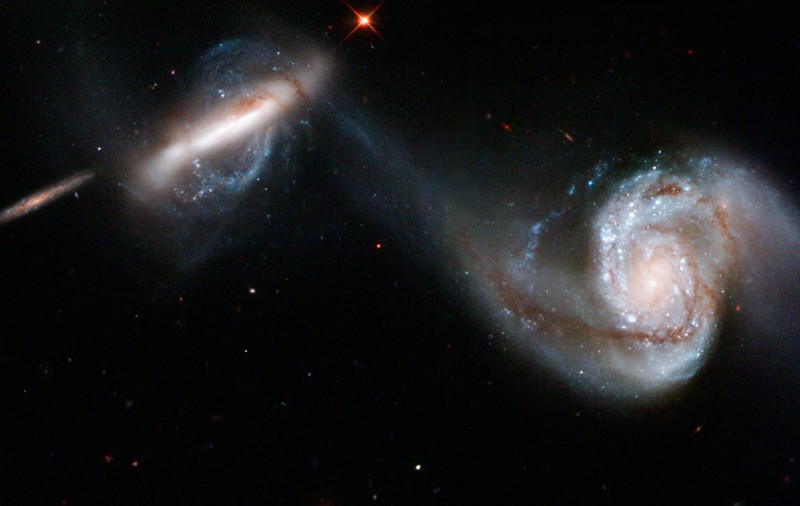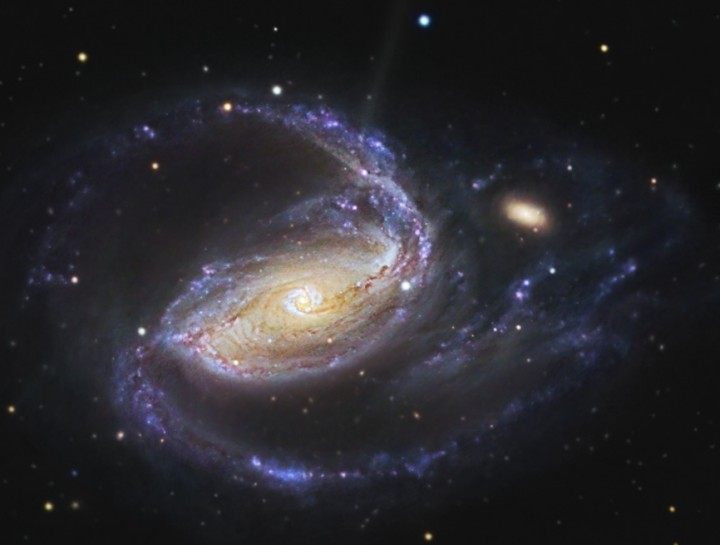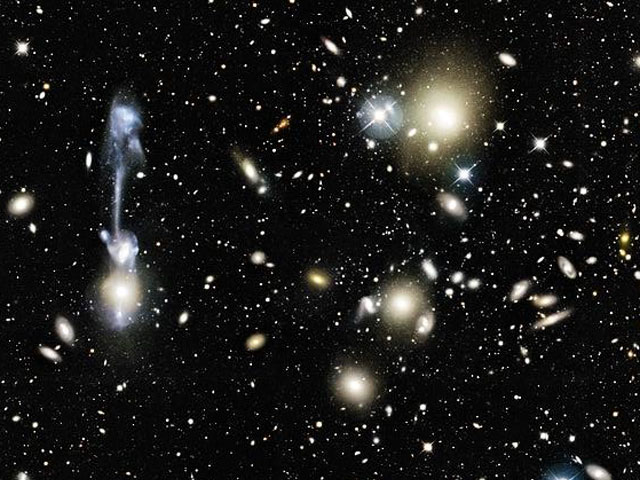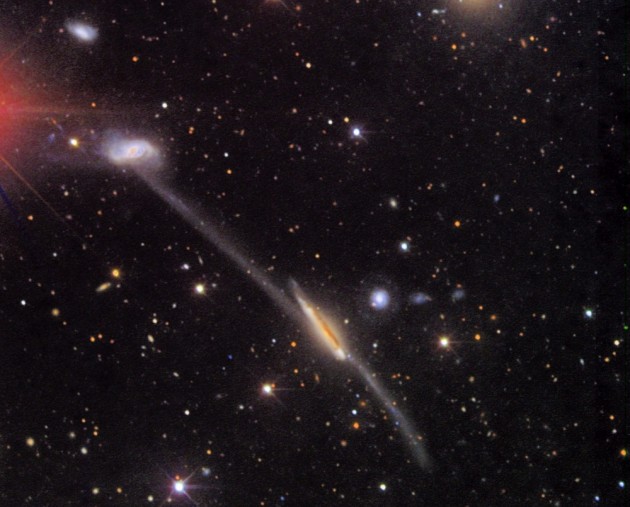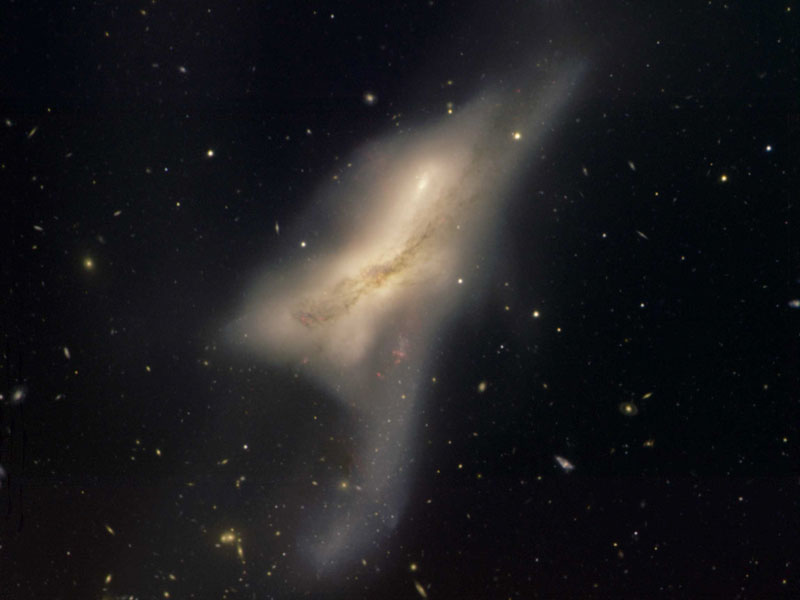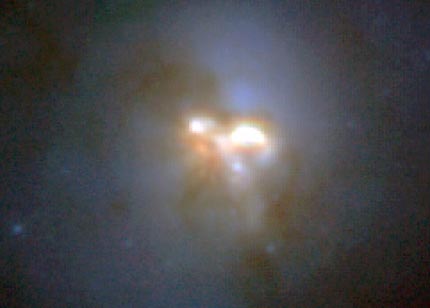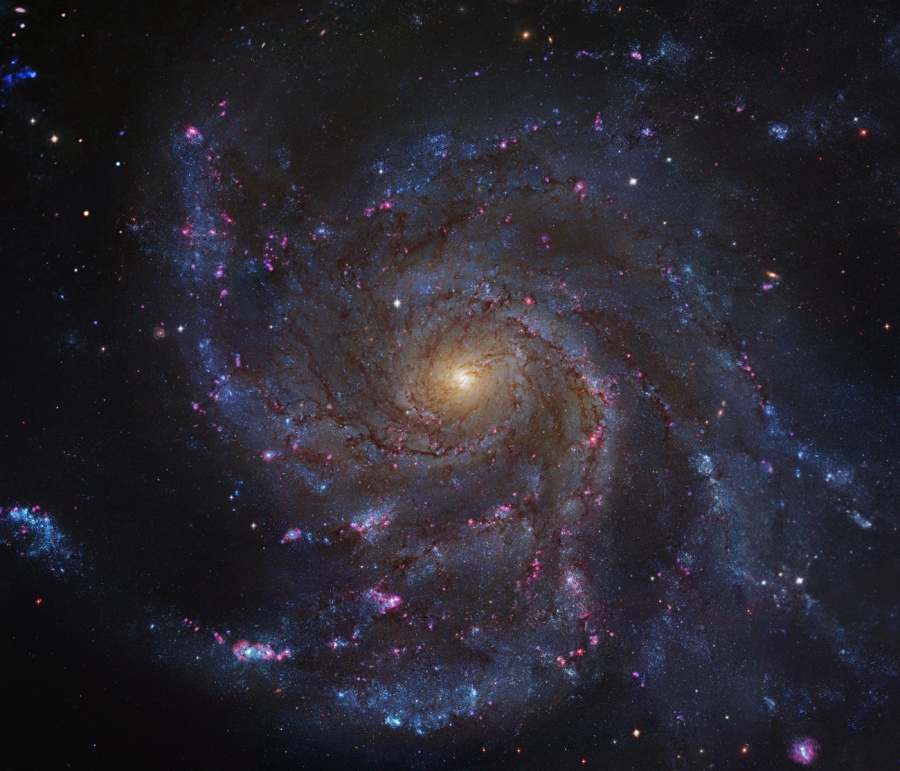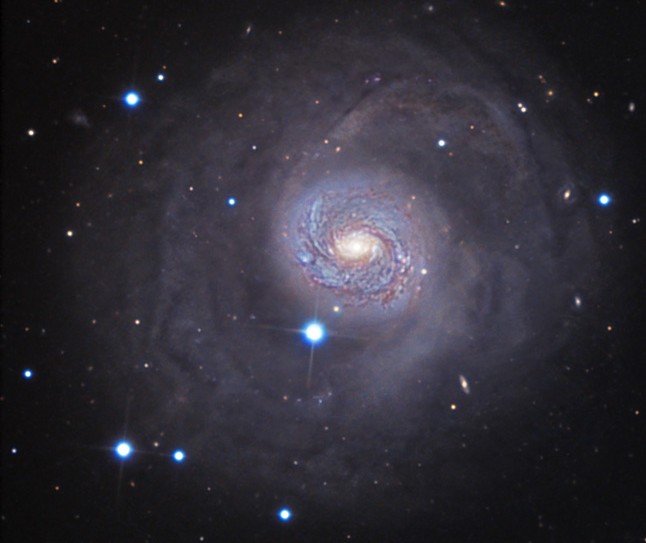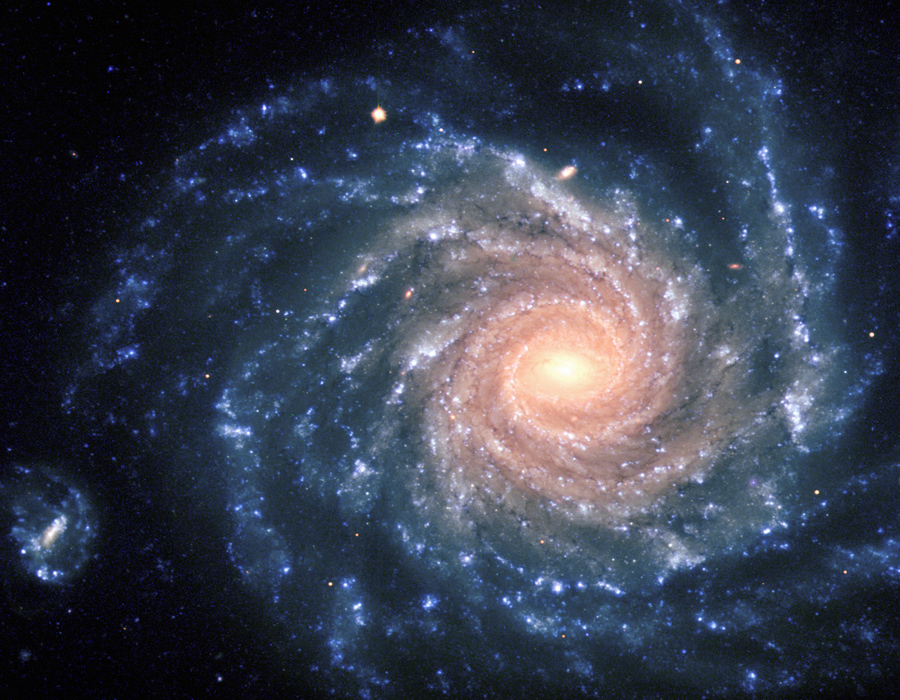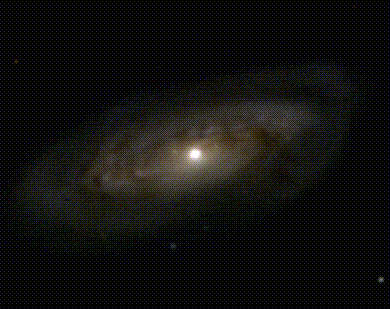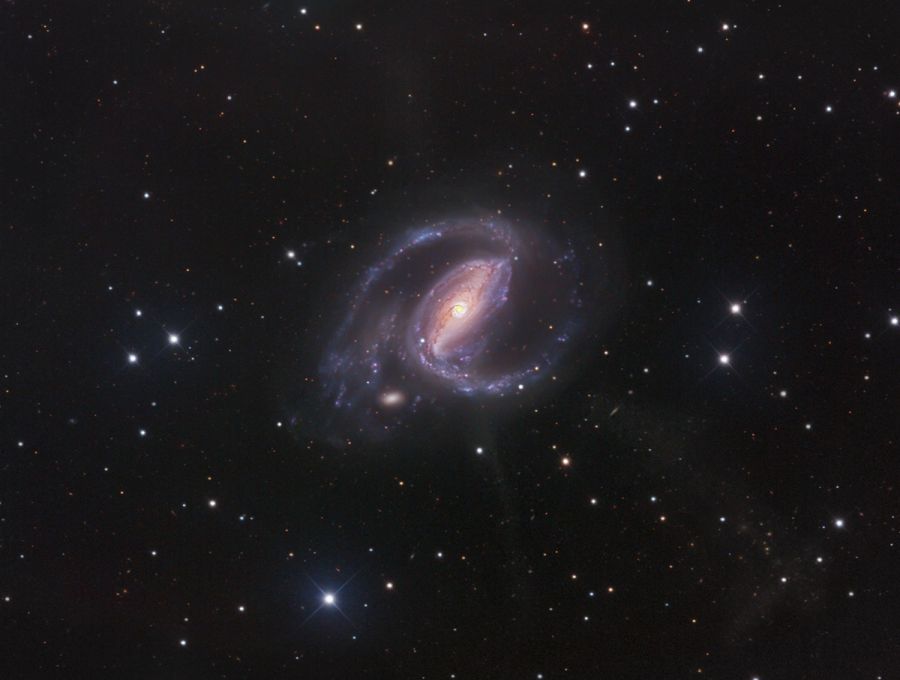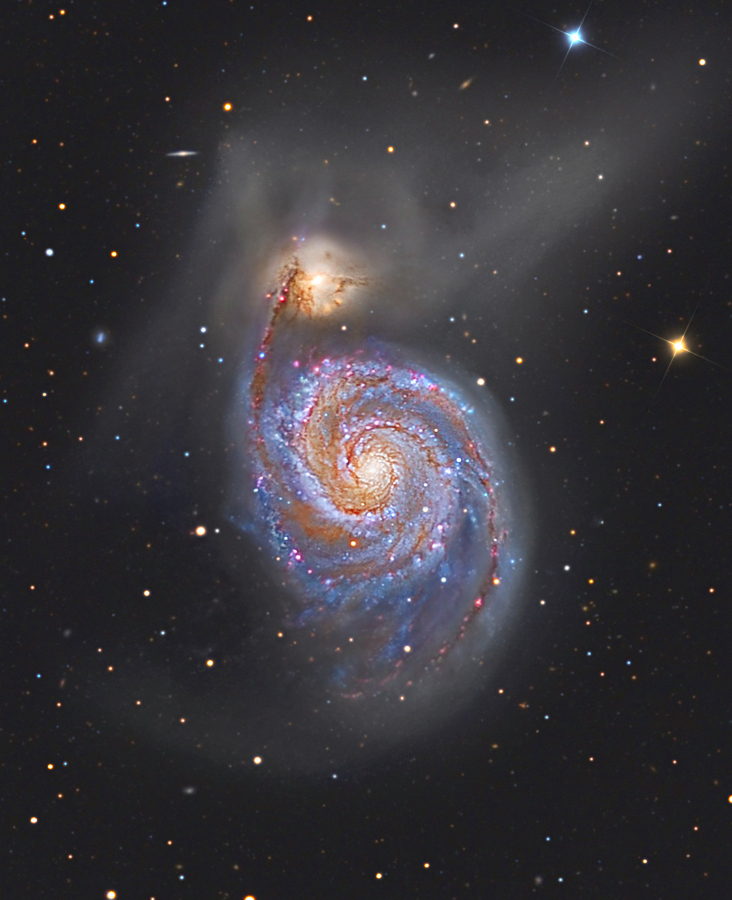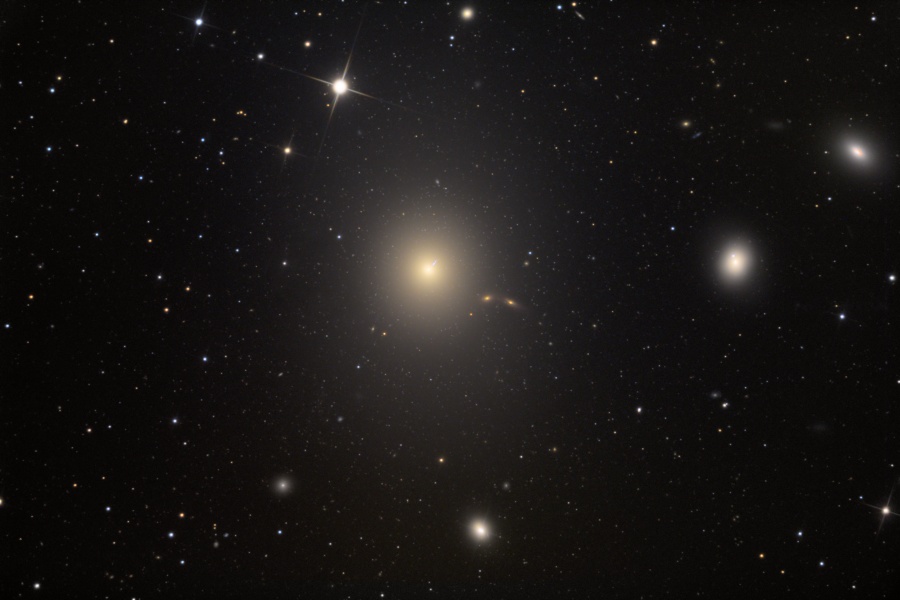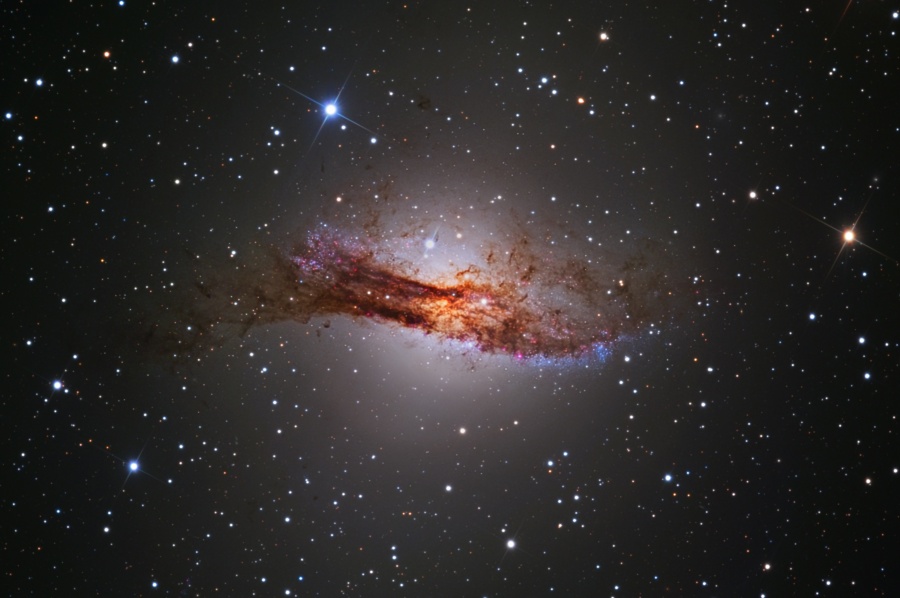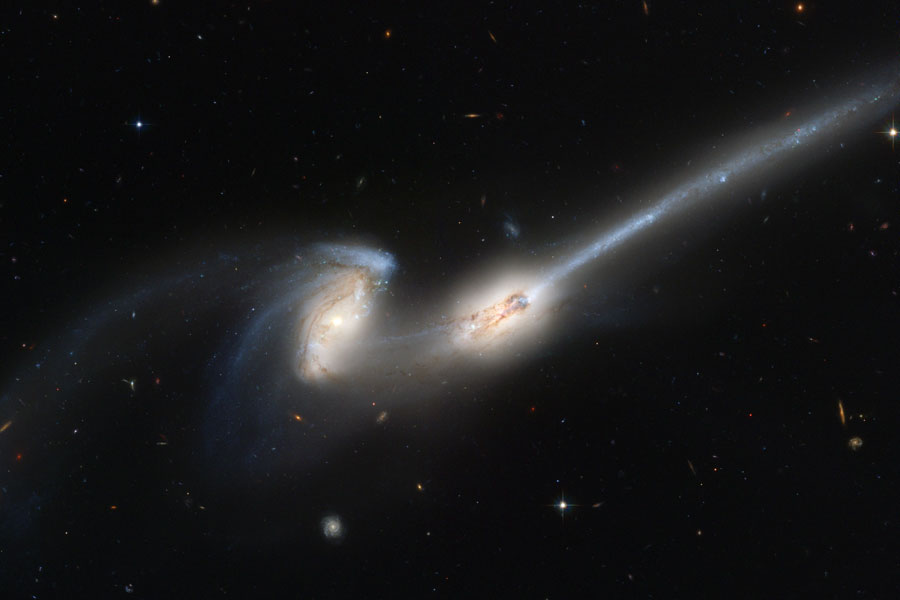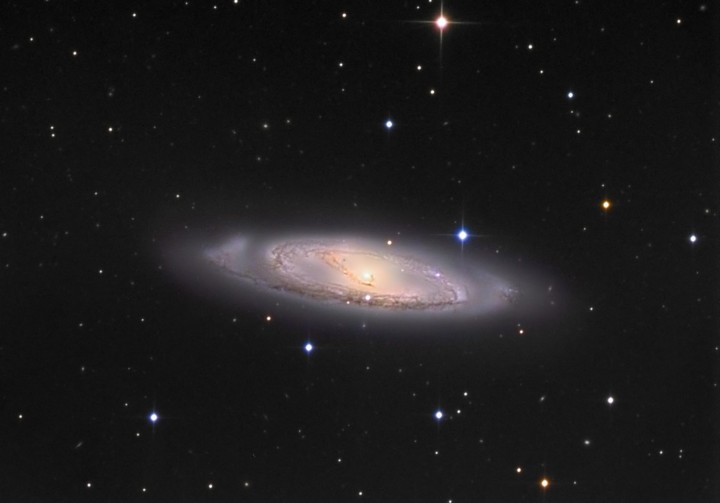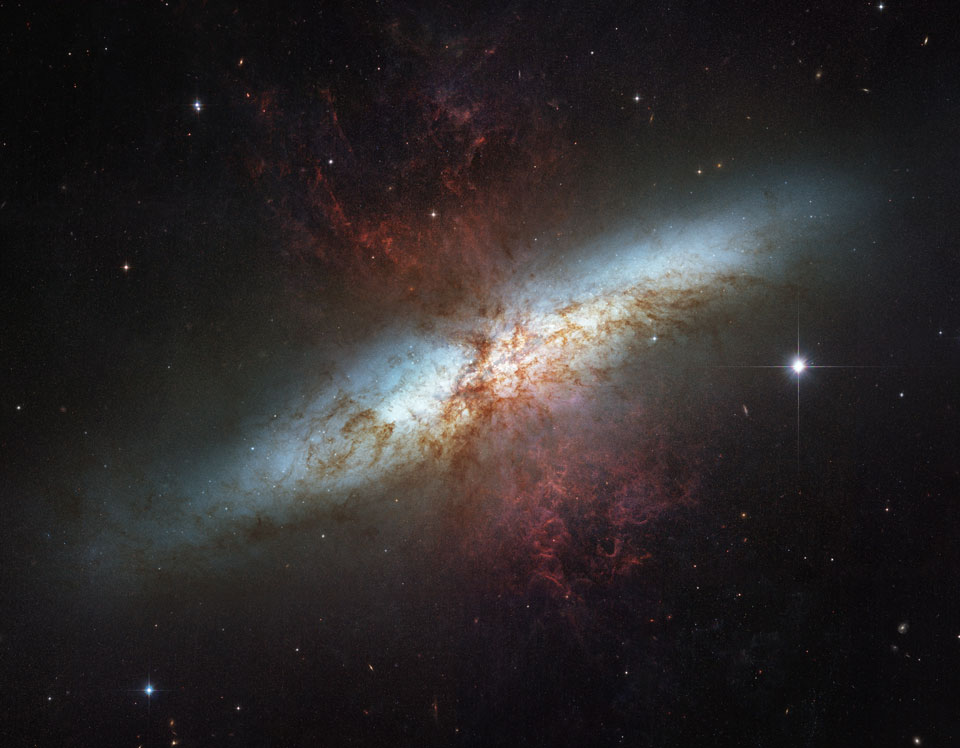The primary goal of the catalog was to present photographs of examples of the different kinds of peculiar structures found among nearby galaxies. Arp realized that the reason why galaxies formed into spiral or elliptical shapes was not well understood. He perceived peculiar galaxies as small "experiments" that astronomers could use to understand the physical processes that distort spiral or elliptical galaxies. With this atlas, astronomers had a sample of peculiar galaxies that they could study in more detail. The atlas does not present a complete overview of every peculiar galaxy in the sky but instead provides examples of the different phenomena as observed in nearby galaxies.
2012 January 27 About 40,000 light-years across, pretty, irregular galaxy NGC 3239 lies near the center of this lovely field of galaxies in the galaxy rich constellation Leo. At a distance of only 25 million light-years it dominates the frame, sporting a peculiar arrangement of structures, young blue star clusters and star forming regions, suggesting that NGC 3239 (aka Arp 263) is the result of a galaxy merger. Appearing nearly on top of the pretty galaxy is a bright, spiky, foreground star, a nearby member of our own Milky Way galaxy almost directly along our line-of-sight to NGC 3239. Still, NGC 3239 is notable for hosting this year's first confirmed supernova, designated SN 2012A. It was discovered early this month by supernova hunters Bob Moore, Jack Newton, and Tim Puckett. Indicated in a cropped version of the wider image, SN 2012A is just below and right of the bright foreground star. Of course, based on the light-travel time to NGC 3239, the supernova explosion itself occurred 25 million years ago, triggered by the core collapse of a massive star.
2011 September 22
2008 April 30 Linking spiral arms, two large colliding galaxies are featured in this remarkable cosmic portrait constructed using image data from the Hubble Legacy Archive. Recorded in astronomer Halton Arp's Atlas of Peculiar Galaxies as Arp 272, the pair is otherwise known as NGC 6050 near center, and IC 1179 at upper right. A third galaxy, likely also a member of the interacting system, can be spotted above and left of larger spiral NGC 6050. They lie some 450 million light-years away in the Hercules Galaxy Cluster. At that estimated distance, the picture spans over 150 thousand light-years. Although this scenario does look peculiar, galaxy collisions and their eventual mergers are now understood to be common, with Arp 272 representing a stage in this inevitable process. In fact, the nearby large spiral Andromeda Galaxy is known to be approaching our own galaxy and Arp 272 may offer a glimpse of the far future collision between Andromeda and the Milky Way.
2011 August 29 Scanning the skies for galaxies, Canadian astronomer Paul Hickson and colleagues identified some 100 compact groups of galaxies, now appropriately called Hickson Compact Groups. The four prominent galaxies seen in this intriguing telescopic skyscape are one such group, Hickson 44, about 100 million light-years distant toward the constellation Leo. The two spiral galaxies in the center of the image are edge-on NGC 3190 with its distinctive, warped dust lanes, and S-shaped NGC 3187. Along with the bright elliptical, NGC 3193 at the right, they are also known as Arp 316. The spiral in the upper left corner is NGC 3185, the 4th member of the Hickson group. Like other galaxies in Hickson groups, these show signs of distortion and enhanced star formation, evidence of a gravitational tug of war that will eventually result in galaxy mergers on a cosmic timescale. The merger process is now understood to be a normal part of the evolution of galaxies, including our own Milky Way. For scale, NGC 3190 is about 75,000 light-years across at the estimated distance of Hickson 44.
2011 July 7 Peculiar spiral galaxy Arp 78 is found within the boundaries of the head strong constellation Aries, some 100 million light-years beyond the stars and nebulae of our Milky Way galaxy. Also known as NGC 772, the island universe is over 100 thousand light-years across and sports a single prominent outer spiral arm in this detailed cosmic portrait. Its brightest companion galaxy, compact NGC 770, is toward the upper right of the larger spiral. NGC 770's fuzzy, elliptical appearance contrasts nicely with a spiky foreground Milky Way star in matching yellowish hues. Tracking along sweeping dust lanes and lined with young blue star clusters, Arp 78's large spiral arm is likely due to gravitational tidal interactions. Faint streams of material seem to connect Arp 78 with its nearby companion galaxies.
2011 April 21
2008 November 15 The spiky stars in the foreground of this sharp cosmic portrait are well within our own Milky Way Galaxy. The two eye-catching galaxies lie far beyond the Milky Way, at a distance of over 300 million light-years. Their distorted appearance is due to gravitational tides as the pair engage in close encounters. Cataloged as Arp 273 (also as UGC 1810), the galaxies do look peculiar, but interacting galaxies are now understood to be common in the universe. In fact, the nearby large spiral Andromeda Galaxy is known to be some 2 million light-years away and approaching the Milky Way. Arp 273 may offer an analog of their far future encounter. Repeated galaxy encounters on a cosmic timescale can ultimately result in a merger into a single galaxy of stars. From our perspective, the bright cores of the Arp 273 galaxies are separated by only a little over 100,000 light-years. The release of this stunning vista celebrates the 21st anniversary of the Hubble Space Telescope in orbit.
2011 February 26 This colorful cosmic skyscape features a peculiar system of galaxies cataloged as Arp 227 some 100 million light-years distant. Swimming within the boundaries of the constellation Pisces, Arp 227 consists of the two galaxies prominent on the left; the curious shell galaxy NGC 474 and its blue, spiral-armed neighbor NGC 470. The faint, wide arcs or shells of NGC 474 could have been formed by a gravitational encounter with neighbor NGC 470. Alternately the shells could be caused by a merger with a smaller galaxy producing an effect analogous to ripples across the surface of a pond. Remarkably, the large galaxy on the right hand side of the deep image, NGC 467, appears to be surrounded by faint shells too, evidence of another interacting galaxy system. Intriguing background galaxies are scattered around the field that also includes spiky foreground stars. Of course, those stars lie well within our own Milky Way Galaxy. The field of view spans 25 arc minutes or about 1/2 degree on the sky.
2010 September 26
2006 January 8
2004 May 15
2002 May 2
2010 August 13 A remarkable telescopic composition in yellow and blue, this scene features a trio of interacting galaxies almost 90 million light-years away, toward the constellation Virgo. On the left, two, spiky, foreground Milky Way stars echo the trio galaxy hues, a reminder that stars in our own galaxy are like those in the distant island universes. Predominately yellow, with sweeping spiral arms and dust lanes, NGC 5566 is enormous, about 150,000 light-years across. Just below it lies small, blue NGC 5569. Near center, the third galaxy, NGC 5560, is multicolored and apparently stretched and distorted by its interaction with NGC 5566. The galaxy trio is also included in Halton Arp's 1966 Atlas of Peculiar Galaxies as Arp 286. Of course, such cosmic interactions are now appreciated as a common part of the evolution of galaxies.
2010 July 2
2008 July 31 Galaxies NGC 5216 (top) and NGC 5218 really do look like they are connected by a string. Of course, that string is a cosmic trail of gas, dust, and stars about 22,000 light-years long. Also known as Keenan's system (for its discoverer) and Arp 104, the interacting galaxy pair is some 17 million light-years away in the constellation Ursa Major. The debris trail that joins them, along with NGC 5218's comma-shaped extension and the distorted arms of NGC 5216, are a consequence of mutual gravitational tides. The tides disrupt the galaxies as they repeatedly swing close to one another. Drawn out over billions of years, the encounters will likely result in their merger into a single galaxy of stars. Such spectacular galactic mergers are now understood to be a normal part of the evolution of galaxies, including our own Milky Way.
2009 November 9 Where do stars form when galaxies collide? To help find out, astronomers imaged the nearby galaxy merger NGC 2623 in high resolution with the Hubble Space Telescope in 2007. Analysis of this Hubble image and images of NGC 2623 in infrared light by the Spitzer Space Telescope, in X-ray light by XMM-Newton, and in ultraviolet light by GALEX, indicate that two originally spiral galaxies appear now to be greatly convolved and that their cores have unified into one active galactic nucleus (AGN). Star formation continues around this core near the above image center, along the stretched out tidal tails visible on either side, and perhaps surprisingly, in an off-nuclear region on the upper left where clusters of bright blue stars appear. Galaxy collisions can take hundreds of millions of years and take several gravitationally destructive passes. NGC 2623, also known as Arp 243, spans about 50,000 light years and lies about 250 million light years away toward the constellation of the Crab (Cancer). Reconstructing the original galaxies and how galaxy mergers happen is often challenging, sometimes impossible, but generally important to understanding how our universe evolved.
2009 April 7 Two galaxies are squaring off in Virgo and here are the latest pictures. When two galaxies collide, the stars that compose them usually do not. This is because galaxies are mostly empty space and, however bright, stars only take up only a small fraction of that space. But during the collision, one galaxy can rip the other apart gravitationally, and dust and gas common to both galaxies does collide. If the two galaxies merge, black holes that likely resided in each galaxy center may eventually merge. Because the distances are so large, the whole thing takes place in slow motion -- over hundreds of millions of years. Besides the two large spiral galaxies, a smaller third galaxy is visible on the far left of the above image of Arp 274, also known as NGC 5679. Arp 274 spans about 200,000 light years across and lies about 400 million light years away toward the constellation of Virgo.
2008 November 4 How could a galaxy become shaped like a ring? Even more strange: how could two? The rim of the blue galaxy pictured on the right shows an immense ring-like structure 30,000 light years in diameter composed of newly formed, extremely bright, massive stars. This blue galaxy is part of the interacting galaxy system known as Arp 147, and shows a ring because it has recently collided with the other galaxy in the frame, the red galaxy on the left. Unusually, even this red galaxy shows a ring like band, although it is seen nearly edge-on. When galaxies collide, they pass through each other -- their individual stars rarely come into contact. Clouds of interstellar gas and dust become condensed, causing a wave of star formation to move out from the impact point like a ripple across the surface of a pond. The above image was taken last week by NASA's Hubble Space Telescope to demonstrate the ability of its Wide Field Planetary Camera 2 after some recent technical difficulties.
2008 July 21 What will become of these galaxies? Spiral galaxies NGC 5426 and NGC 5427 are passing dangerously close to each other, but each is likely to survive this collision. Most frequently when galaxies collide, a large galaxy eats a much smaller galaxy. In this case, however, the two galaxies are quite similar, each being a sprawling spiral with expansive arms and a compact core. As the galaxies advance over the next tens of millions of years, their component stars are unlikely to collide, although new stars will form in the bunching of gas caused by gravitational tides. Close inspection of the above image taken by the 8-meter Gemini-South Telescope in Chile shows a bridge of material momentarily connecting the two giants. Known collectively as Arp 271, the interacting pair spans about 130,000 light years and lies about 90 million light-years away toward the constellation of Virgo. Quite possibly, our Milky Way Galaxy will undergo a similar collision with the neighboring Andromeda Galaxy in about five billion years.
2007 November 1 A cosmic bridge of stars, gas, and dust stretches for over 75,000 light-years and joins this peculiar pair of galaxies cataloged as Arp 87. The bridge is strong evidence that these two immense star systems have passed close to each other and experienced violent tides induced by mutual gravity. As further evidence, the face-on spiral galaxy on the right, also known as NGC 3808A, exhibits many young blue star clusters produced in a burst of star formation. The twisted edge-on spiral on the left (NGC 3808B) seems to be wrapped in the material bridging the galaxies and surrounded by a curious polar ring. While such interactions are drawn out over billions of years, repeated close passages should ultimately result in the merger of this pair of galaxies into a larger single galaxy of stars. Although this scenario does look peculiar, galactic mergers are thought to be common, with Arp 87 representing a stage in this inevitable process. The Arp 87 pair are about 300 million light-years distant toward the constellation Leo. The prominent edge-on spiral at the far left appears to be a more distant background galaxy and not involved in the on-going merger.
2007 February 16 NGC 2685 is a confirmed polar ring galaxy - a rare type of galaxy with stars, gas and dust orbiting in rings perpendicular to the plane of a flat galactic disk. The bizarre configuration could be caused by the chance capture of material from another galaxy by a disk galaxy, with the captured debris strung out in a rotating ring. Still, observed properties of NGC 2685 suggest that the rotating ring structure is remarkably old and stable. In this fascinating view of the peculiar system also known as Arp 336 or the Helix galaxy, the strange, perpendicular rings are easy to trace as they pass in front of the galactic disk, along with other disturbed outer structures. NGC 2685 is about 50,000 light-years across and 40 million light-years away in the constellation Ursa Major.
2006 December 1 A smaller companion seems wrapped in the spiral arms of enigmatic galaxy NGC 1097. This amazingly deep image of the peculiar spiral system, also known as Arp 77, actually combines data from two telescopes, one in the northern and one in the southern hemisphere of planet Earth. The faint details revealed include hints of a mysterious jet emerging toward the top of the view. Seen to be about 42,000 light-years from the larger galaxy's center, the companion galaxy is gravitationally interacting with the spiral and will ultimately merge with it. NGC 1097's center also harbors a massive black hole. NGC 1097 is located about 45 million light-years away in the chemical constellation Fornax.
2005 November 22 What is a guitar doing in a cluster of galaxies? Colliding. Clusters of galaxies are sometimes packed so tight that the galaxies that compose them collide. A prominent example occurs on the left of the above image of the rich cluster of galaxies Abell 1185. There at least two galaxies, cataloged as Arp 105 and dubbed The Guitar for their familiar appearance, are pulling each other apart gravitationally. Most of Abell 1185's hundreds of galaxies are elliptical galaxies, although spiral, lenticular, and irregular galaxies are all clearly evident. Many of the spots on the above image are fully galaxies themselves containing billions of stars, but some spots are foreground stars in our own Milky Way Galaxy. Recent observations of Abell 1185 have found unusual globular clusters of stars that appear to belong only to the galaxy cluster and not to any individual galaxy. Abell 1185 spans about one million light years and lies 400 million light years distant.
2005 October 8
2003 October 10 A spectacular bridge of stars and gas stretches for nearly 250,000 light-years and joins this famous peculiar pair of galaxies cataloged as Arp 295. The cosmic bridge between the galaxies and the long tail extending below and right of picture center are strong evidence that these two immense star systems have passed close to each other in the past, allowing violent tides induced by mutual gravity to create the eye-catching plumes of stellar material. While such interactions are drawn out over billions of years, repeated close passages should ultimately result in the merger of this pair of galaxies into a larger single galaxy of stars. Although this scenario does look peculiar, galactic mergers are thought to be common, with Arp 295 representing an early stage of this inevitable process. The Arp 295 pair are the largest of a loose grouping of galaxies about 270 million light-years distant toward the constellation Aquarius. This deep color image of the region was recorded in September 2003 using the USNO 1 meter telescope near Flagstaff, Arizona.
2005 September 12 Is this one galaxy or two? The jumble of stars, gas, and dust that is NGC 520 is now thought to incorporate the remains of two separate galaxies. A combination of observations and simulations indicate the NGC 520 is actually the collision of two disk galaxies. Interesting features of NGC 520 include an unfamiliar looking tail of stars at the image bottom and a perhaps more familiar looking band of dust running diagonally across the image center. A similar looking collision might be expected were our disk Milky Way Galaxy to collide with our large galactic neighbor Andromeda (M31). The collision that defines NGC 520 started about 300 million years ago and continues today. Although the speeds of stars are fast, the distances are so vast that the interacting pair will surely not change its shape noticeably during our lifetimes. NGC 520, at visual magnitude 12, has been noted to be one of the brightest interacting galaxies on the sky, after interacting pairs of galaxies known as the Antennae. NGC 520 was imaged above in spectacular fashion by the Gemini Observatory in Hawaii, USA. Also known as Arp 157, NGC 520 lies about 100 million light years distant, spans about 100 thousand light years, and can be seen with a small telescope toward the constellation of the Fish (Pisces).
2003 December 11 From planet Earth, we view this strongly interacting pair of galaxies, cataloged as Arp 81, as they were only about 100 million years after their mutual closest approach. The havoc wreaked by gravity during their ominous encounter is detailed in this color composite image from the Hubble Space Telescope, showing twisted streams of gas and dust, a chaos of massive star formation, and a tidal tail stretching for 200 thousand light-years or so as it sweeps behind the cosmic wreckage. Also known as NGC 6622 (left) and NGC 6621, the galaxies are roughly equal in size but are destined to merge into one large galaxy in the distant future, making repeated approaches until they finally coalesce. Located in the constellation Draco, the galaxies are 280 million light-years away. The dark vertical band which seems to run through NGC 6621's location is a camera artifact.
August 31, 1997
August 22, 1996 Is this one galaxy or two? Analysis of Arp 230 has shown evidence that this seemingly single spiral galaxy is actually the result of the recent collision of two spiral galaxies. The slow motion collision took place over about 100 million years and induced a burst of star formation that has begun to subside. The collision apparently had many similarities to the colliding galaxy sequence in the IMAX movie "Cosmic Voyage."
June 17, 1997 Arp 220 is the brightest object in the local universe. But why does it shine so brightly? Arp 220 was cataloged as a peculiar galaxy in the 1960s. In the late 1980s, it was discovered to be an ultraluminous infrared galaxy and headed a list compiled from observations with the now-defunct IRAS satellite. New observations with the Hubble Space Telescope are quite revealing. Photos by NICMOS in the infrared taken in April and released just last week now better resolve the two colliding spiral galaxies at the center of Arp 220. A result of this spiral collision are fantastic knots of new star formation visible as the bright spots on the above photograph. Below the "half-moon" shaped knot on the right is a massive disk of dust possibly hiding a dying spiral's central black hole. The bright knot to the left is the center of the other broken spiral galaxy. The galaxy cores are about 1200 light years apart and are orbiting each other.
